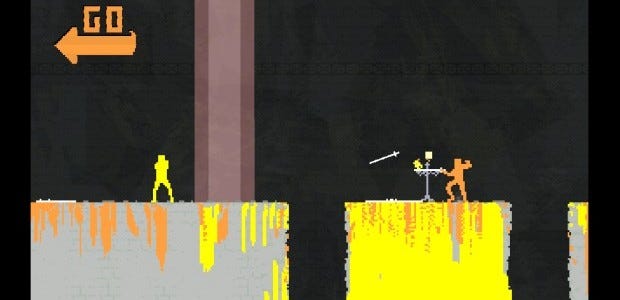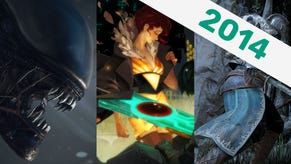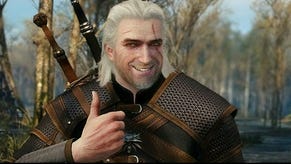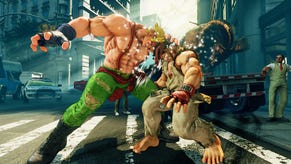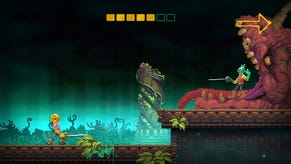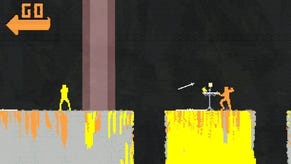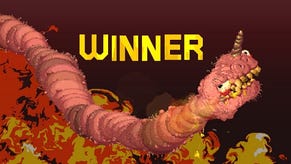Wot I Think: Nidhogg
In Like Flynn
Nidhogg is to swordfighting what Sensible Soccer is to foot-to-ball. It's the International Track & Field of sticking people with pointy objects. It's a two-player multiplayer distillation of a swashbuckling action movie, with every extraneous element burned away until all that's left is a couple of buttons, a few moves and twice the concentration of drama and excitement.
This is Wot I Think.
Nidhogg is easy to explain.
Two players in an arena. Kill your opponent for the right to advance past them, moving from screen to screen, killing and dodging your respawning foe until a giant worm eats you, declaring you the winner.
Hold your sword in three positions: high, middle and low. Crouch and attack to perform a swipe kick. Jump and attack to perform a dive kick. Push up and attack to throw your sword. Attack a prone opponent to snap their neck. Move your sword into your opponent's from above or below to disarm them. Do it all by pressing two buttons.
Nidhogg is difficult to explain.
Two friends sat in front of a single screen. Kill your opponent for the right to advance past them, then get killed by them before you can, as they've respawned in front of you.
Throw your sword into their face, roll to pick it up again, fall down a hole. Try it again only faster. Beat your opponent. Beat that respawn time. Get to the next screen, die, and watch your progress undone. Laugh. Woop. Wince. Scream.
Two friends sat in front of a single screen, and a crowd behind them. Can we play?
Yes. Nidhogg is easy to explain. X attacks, A jumps. Have fun.
An hour passes, then two. Friend X attacks quickly, using a lot of divekicks to disarm opponents. Friend A stays on the periphery, fencing, patiently waiting for you to come at them. Friend Y likes to try to avoid their opponents entirely, sliding under attacks and bolting for the next screen. Friend B likes to crouch and waddle and jump. They call this "The Wildebeest", and they combine it with skewering their opponents and then moving their sword up and down for as long as possible while the paint-like blood spews into the scenery. They scream while they do this. Friends A-Z each have their personal style, and all of them are laughing. Nidhogg is hard to explain.

Nidhogg has been doing this to people for years, travelling exhibition spaces in North America, and being passed between friends on USB sticks by those lucky enough to have previous builds. This is the first time it's been available to buy to the general public: four stages, a singleplayer with a decent, characterful AI, and online multiplayer.
Its main strength still lies in that same screen multiplayer, though. Nidhogg does what party games are supposed to: hold everyone's attention, but in ways which make everyone more social, not less. It's a game that anyone can start playing, but everyone can play their own way, and where even simple actions by inexperienced players combine to create an impressive, high-wire choreography.
There's a video below of me playing against the computer (I'm the yellow guy). At one point I throw a sword at my unarmed enemy, who ducks it. I follow the sword by moving in for a melee attack, but they dive kick me to the ground and leap towards me with a quick flurry of blows. I roll away, grabbing a sword as I do. I dodge their next attack, turn, and throw my sword directly into their head. The whole thing happens in six seconds.
I die again less than three seconds later.
These moments happen again and again. I throw my sword at an opponent, they block it. They throw theirs, I jump it and switch straight into a divekick. They kick me out of the air and I fall into the abyss and die. This takes less than two seconds. It's one part of the larger ongoing fight and it happens so quickly, no one has time to breathe before the competition has resumed.
The pace of it is fast and frantic and panicked, encouraged by constant death and rapid respawns and off-kilter electronic music and background art that pulses like a visual migraine. The tension of those same deaths and of your opponent's steady advances towards the finish line encourages you to always care, to always be purposeful.
The combination smears your every action in desperation. Everything needs to happen faster, and everything seems to be just slightly beyond your control. This is what makes it funny. It's also a great antidote to the terrible fear of competing against your friends. It's hard - although admittedly not impossible - to be annoyed at a game in which both players regularly cause their own deaths, or where death is so frequent as to hardly matter, or where the ultimate win condition is to be eaten alive by a Norse dragon. You're fighting for a good death, but there are no bad ones.
As a singleplayer game, rushing towards completing its series of AI fights at faster and faster speeds is a pleasing diversion, sustained by the AI which seems as silly and quirky as any person. As a multiplayer game, it's destined to be brought out late at night, whenever you've got friends around. Don't worry, you'll say. Nidhogg is easy to explain.
Nidhogg is available on Steam.
